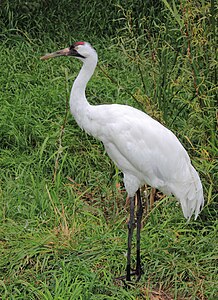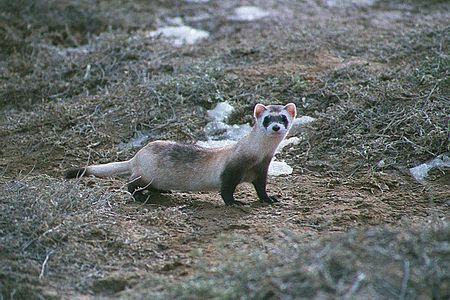User:Rileysteg/Wind Cave National Park
History[edit]
The Lakota, Cheyenne, and other Native American tribes who traveled through and made camps around the area were aware of the cave's existence, as were early Euro-American settlers, but there has been no recorded evidence discovered that anyone actually entered it.
The Lakota (Sioux), an indigenous people who live in the Black Hills region of South Dakota, spoke of a hole that blew air, a place they consider sacred as the site where they first emerged from the underworld where they had lived before the demiurge creation of the world. Originally called Washun Niya, Wind Cave played an important role in the traditions and culture of the Lakota people.[1] The fables of these people tell the story of Tokahe, the first human to emerge from the cave, symbolizing an emergence from the underworld.[2] His story and presence at Wind Cave is an important part of Lakota history, and heavily influences their origin story.[2]
Wind Cave and other areas throughout the Black Hills were important to the native people in other ways beyond spirituality. Nicknamed, euphemistically, as a “super-market,” the areas surrounding the cave provided abundant resources for native survival[2]. Often during the winter seasons, such areas served as ideal spots for camps; much of the game they hunted preferred the shelter provided by the cave and made these areas ideal to become Lakota settlements and hunting grounds.[2]
The eventual dispossession of the Lakota people followed the consistent history of dispossession of indigenous peoples across the country. In 1851 a Treaty was formed at Fort Laramie, entering the tribe into a legal relationship with the U.S. government.[3] Another Treaty of Fort Laramie in 1868 redefined and reduced the borders of Lakota land within the Black Hills.[3] Article two within that treaty allowed for forts to be built within Lakota land and in 1874 General George A. Custer began surveying the land and mistakenly reported a significant presence of gold, despite the geologist on his team of surveyors saying there were no quantities of substance.[3] Miners then began to invade the hills in search of gold, which was against the treaty with the Lakota people, though the government did little to punish such offenses. In 1875 the Lakota title to the land was deemed invalid due to their lack of structural development and supposed “wasting” of the land.[3] When the Dawes Act was passed in 1877, the site was opened to settlers and effectively sealed the dispossession of the Lakota from their ancestral lands.[3]
Effects of Climate Change on Wind Cave and Surrounding Areas[edit]
Throughout the years, the great plains have seen a considerable rise in temperature. Being that Wind Cave is located in the great plains, these temperature rises have already started to affect the park and the area around it.[4]The average temperature rise across the plains has been two degrees Fahrenheit, with some areas seeing increases as high as five degrees Fahrenheit. [4] This trend is projected to cause drought like conditions in the area.[4]
| This is the sandbox page where you will draft your initial Wikipedia contribution.
If you're starting a new article, you can develop it here until it's ready to go live. If you're working on improvements to an existing article, copy only one section at a time of the article to this sandbox to work on, and be sure to use an edit summary linking to the article you copied from. Do not copy over the entire article. You can find additional instructions here. Remember to save your work regularly using the "Publish page" button. (It just means 'save'; it will still be in the sandbox.) You can add bold formatting to your additions to differentiate them from existing content. |
Flora and fauna[edit]

Wind Cave National Park protects a diverse ecosystem with eastern and western plant and animal species. Wildlife that inhabits this park include raccoons, elk, bison, coyotes, skunks, badgers, ermines, black-footed ferrets, cougars, bobcats, red foxes, minks, whooping crane, pronghorn and prairie dogs. The Wind Cave bison herd is one of only four free-roaming and genetically pure herds on public lands in North America. The other three herds are the Yellowstone Park bison herd, the Henry Mountains bison herd in Utah, and on Elk Island in Alberta, Canada. The Wind Cave bison herd is currently brucellosis-free.[5]
Endangered Species:[edit]
The black-footed ferret and whooping crane are on the endangered species list. [6][7] The whooping crane population in Wind Cave National Park is considered a non-self-sustaining wild population. [7]
Added Endangered species section and added whooping crane to wildlife list in above paragraph.
Article Draft[edit]
Lead[edit]
Article body[edit]
References[edit]
- ^ Fritz, Jessica Garcia, and Federico Garcia Lammers. "ORIGINS FROM WIND CAVE WASHUN NIYA: SACRED SPACE AS CONTESTED TERRITORY." GENIUS LOCI: 33.
- ^ a b c d Albers, Patricia; Berndt, Christina; Brown, Elizabeth; Kelly, Yvonne; Kittelson, Vanessa; Rossina, Kim; Schlegel, Stacy; Yardley, Andrea (2003-01-01). "The Home of the Bison : An Ethnographic and Ethnohistorical Study of Traditional Cultural Affiliations to Wind Cave National Park". U.S. National Park Service Publications and Papers.
- ^ a b c d e Eagle, Bear (2018). Oníya Ošóka: The Interpretation of Oglála Lakȟóta Continuing and Historical Relational Connections at Wind Cave National Park (Thesis). UCLA.
- ^ a b c Springs, Mailing Address: 26611 US Highway 385 Hot; Us, SD 57747 Phone: 605 745-4600 Contact. "Climate Change - Wind Cave National Park (U.S. National Park Service)". www.nps.gov. Retrieved 2022-02-26.
{{cite web}}: CS1 maint: numeric names: authors list (link) - ^ Wind Cave brochure, National Park Service, GPO, WDC
- ^ "Map of threatened and endangered species in National Parks". Wildlife and Wild Lands. Retrieved 2022-03-29.
- ^ a b "ECOS: Species Profile". ecos.fws.gov. Retrieved 2022-04-11.


